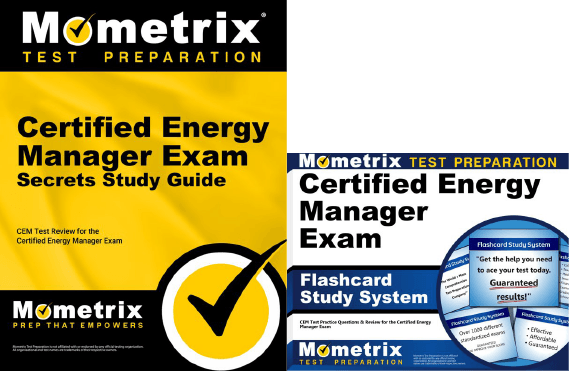If you need help studying for the Certified Energy Manager (CEM®) exam or just want some more information about what the test is like, you’ve come to the right place.
Click below to take a free CEM practice test!
CEM Exam Eligibility
Before you can register to take the Certified Energy Manager exam, you’ll have to meet at least ONE of the requirements below:
- You need a four-year degree in engineering or architecture.
- If you don’t have this degree, you must possess a Professional Engineer (PE) or Registered Architect (RA) license with at least three years of energy engineering/management experience.
- You need a four-year degree in physics, earth science, environmental science, or technology and at least four years of energy engineering/management experience.
- You need a four-year degree in business and at least five years of energy engineering/management experience.
- You need a two-year associate degree in energy management and at least six years of energy engineering/management experience.
- You need a two-year technical degree and at least eight years of energy engineering/management experience.
- You need at least ten years of verified energy engineering/management experience.
If you meet one of these requirements, you’re set to begin the registration process!
What’s on the Exam?
First, let’s talk about the questions on the exam. There are 130 multiple-choice and true-or-false questions total, but only 120 of the questions will count toward your score. Why is that?
The 10 unscored questions on the exam are called “trial” questions. These are added to the exam to determine if they’re good enough questions to add to future versions of the test.
The trick is that you won’t have any way of knowing which questions are scored and which ones are trial questions. They will appear just like the scored questions throughout the test.
The time limit for the exam is 4 hours. There aren’t any scheduled breaks, but you’re free to take restroom breaks as needed.
Let’s take a closer look at the different sections of the CEM exam.
1. Energy and Sustainability Policies, Codes, and Standards
6%-8% of the exam
- National energy policies
- State and local energy codes
- International energy standards
- Green building rating systems
- Renewable energy policies and incentives
2. Energy Rates, Tariffs, and Supply Options
5%-7% of the exam
- Time-of-use pricing
- Demand charges
- Real-time pricing
- Deregulated energy markets
- Power purchase agreements (PPAs)
- Demand response programs
- Distributed generation economics
3. Energy Audits and Instrumentation
7%-11% of the exam
- Walk-through audits
- Detailed audits
- Investment-grade audits
- Measurement and verification (M&V) practices
- Energy monitoring tools
- Data analysis tools
4. Energy Accounting and Economics
6%-10% of the exam
- Energy cost accounting principles
- Lifecycle cost analysis
- Payback period
- Internal rate of return (IRR)
- Net present value (NPV)
- Cost-benefit analysis
5. Electrical Power Systems and Motors
7%-11% of the exam
- Electrical power distribution components
- Power factor and correction strategies
- AC induction motors
- Synchronous motors
- Permanent magnet motors
- Motor maintenance strategies
6. Lighting Systems
5%-7% of the exam
- Lighting system design principles
- LED lighting
- Fluorescent lighting
- High-intensity discharge (HID) lamps
- Daylighting strategies and controls
7. Hvac Systems and Building Envelope
10%-16% of the exam
- HVAC system types
- Building envelope components
- HVAC controls
- Building automation systems
8. Building Automation, Controls, and Artificial Intelligence Systems
6%-10% of the exam
- Building automation system components
- Energy management control systems
- Integration of artificial intelligence
- Machine learning for building energy optimization
9. Energy Storage Systems
3%-5% of the exam
- Battery storage systems
- Pumped hydro storage
- Thermal storage applications
- Peak shaving with energy storage
10. Boiler and Steam Systems
4%-6% of the exam
- Boiler types
- Condensate recovery in steam systems
- Steam trap management
11. Distributed Generation and Renewable Energy Systems
4%-6% of the exam
- Solar photovoltaic (PV) systems
- Wind turbine systems
- Combined heat and power (CHP) systems
- Microgrids
12. Industrial Systems
6%-8% of the exam
- Industrial processes and energy consumption characteristics
- Energy-efficient industrial technologies
- Compressed air system optimization
13. Operations, Maintenance, and Commissioning
7%-11% of the exam
- Energy management best practices for building operations
- Preventative maintenance programs for energy-using equipment
- Commissioning process for new buildings and equipment
14. Energy Savings Performance Contracting and Measurement and Verification
3%-5% of the exam
- Energy savings performance contracts
- Measurement and Verification (M&V) protocols for energy projects
- Guaranteeing and reporting energy savings
How to Register
Once you’ve ensured that you meet all of the eligibility requirements, you can take the first step toward registering for the exam!
To get started, you’ll need to attend a mandatory prep course for training purposes. You can’t register for the exam without taking this course.
Once you’ve successfully completed the course, you’ll need to submit an application to AEE.
CEM Exam Scores
The CEM exam is scored using a scaled scoring method. Here’s how it works:
For every question you answer correctly, you get one point added to your raw score. At the end of the test, your final raw score will be converted to a scaled score. This scaled score will range somewhere between 0 and 1,040.
The reason your raw score is converted to a scaled score is because everyone who takes the test is given a slightly different set of questions. Since everyone has a different arrangement of questions, and because some questions are harder than others, converting your raw score to a scaled score ensures a more even playing field.
Retaking the Exam
If you didn’t get a passing score on your first try, that’s okay! You can retake the test after a 60-day waiting period.
FAQs
How many questions are on the CEM exam?
The exam contains 130 multiple-choice questions.
How long is the CEM exam?
The exam is timed at 4 hours.
What is the passing score for the CEM exam?
The minimum score you need to pass is 700.
Mometrix Test Preparation is not affiliated with or endorsed by any official testing organization. All organizational and test names are trademarks of their respective owners.



 CEM Study Guide
CEM Study Guide CEM Flashcards
CEM Flashcards